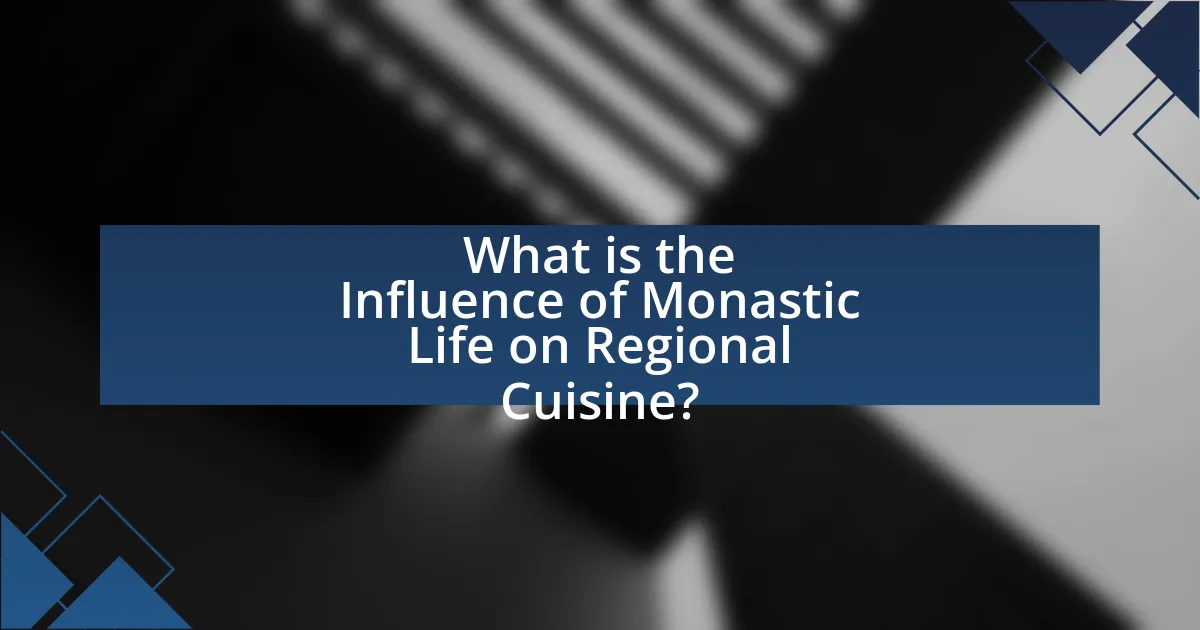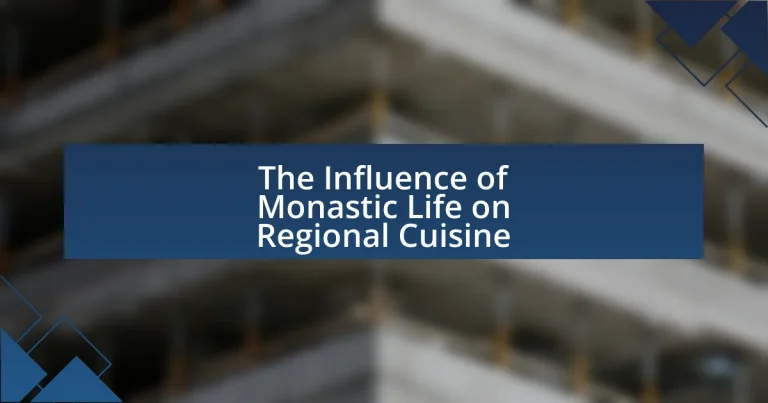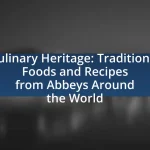The article examines the significant influence of monastic life on regional cuisine, highlighting how monasteries have shaped agricultural practices, preserved traditional recipes, and fostered community through shared meals. It traces the origins and evolution of monastic life, detailing how historical factors led to the establishment of monasteries as centers of agriculture and education. The article also explores core principles of monastic life, such as simplicity and sustainability, and their manifestation in cooking practices. Additionally, it discusses specific cuisines influenced by monastic traditions, key dishes originating from monastic kitchens, and the role of local ingredients and unique cooking methods. Finally, it addresses how modern culinary practices can incorporate monastic influences and the potential benefits for local communities.

What is the Influence of Monastic Life on Regional Cuisine?
Monastic life significantly influences regional cuisine by promoting agricultural practices, preserving traditional recipes, and fostering community through shared meals. Monasteries often cultivated their own gardens and farms, leading to the development of local ingredients and sustainable farming methods, which directly impacted the culinary landscape. For instance, the Benedictine monks in Europe were known for their expertise in brewing beer and producing cheese, which became staples in their regions. Additionally, monastic communities preserved ancient cooking techniques and recipes, ensuring the continuity of culinary traditions. This influence is evident in various regional dishes that incorporate ingredients and methods rooted in monastic practices, highlighting the lasting impact of monastic life on local cuisines.
How did monastic life originate and evolve?
Monastic life originated in the early Christian era, primarily as a response to the desire for spiritual discipline and community living among believers. The first monastic communities emerged in the 3rd century AD in Egypt, with figures like St. Anthony the Great establishing hermitic lifestyles that emphasized asceticism and devotion. Over time, monastic life evolved through the establishment of communal living arrangements, such as those founded by St. Benedict in the 6th century, which introduced structured daily routines and communal worship, leading to the spread of monasticism across Europe. This evolution was marked by the development of various monastic orders, each with distinct rules and practices, such as the Cistercians and Franciscans, which adapted to local cultures and contributed to agricultural advancements and culinary traditions in their regions.
What historical factors contributed to the establishment of monasteries?
The establishment of monasteries was primarily influenced by the spread of Christianity and the desire for religious communities dedicated to prayer and service. In the early centuries of the Christian era, figures like St. Benedict formalized monastic rules, promoting a communal lifestyle that emphasized stability, prayer, and work. This led to the creation of monastic institutions across Europe, particularly during the 4th to 6th centuries, as the Church sought to provide spiritual guidance and education in a rapidly changing society. Additionally, the fall of the Roman Empire created a power vacuum, prompting the Church to establish monasteries as centers of learning, agriculture, and social services, which helped preserve knowledge and culture during the Middle Ages.
How did the role of monasteries change over time?
The role of monasteries changed significantly over time from centers of religious devotion to influential hubs of agriculture, education, and culture. Initially, monasteries primarily focused on spiritual practices and the preservation of religious texts. However, during the Middle Ages, they evolved into agricultural powerhouses, implementing advanced farming techniques and producing surplus food, which contributed to local economies. By the Renaissance, monasteries became centers of learning and art, fostering education and cultural development, while also continuing to influence regional cuisine through their culinary practices and the cultivation of herbs and crops. This transformation illustrates the dynamic impact of monasteries on both spiritual and secular life throughout history.
What are the core principles of monastic life that affect cuisine?
The core principles of monastic life that affect cuisine include simplicity, sustainability, and communal living. Simplicity dictates that monks often prepare meals with minimal ingredients, focusing on whole, unprocessed foods, which aligns with the monastic vow of poverty. Sustainability is emphasized through the cultivation of gardens and the use of local produce, reflecting a commitment to stewardship of the environment. Communal living fosters shared meals, reinforcing community bonds and the practice of hospitality. These principles are evident in various monastic traditions, such as the Benedictines, who historically cultivated their own food and adhered to strict dietary rules, including fasting and abstaining from certain foods, which shaped regional culinary practices.
How do the values of simplicity and sustainability manifest in monastic cooking?
The values of simplicity and sustainability manifest in monastic cooking through the use of minimal ingredients and local, seasonal produce. Monastic communities prioritize straightforward recipes that reflect their spiritual beliefs, often relying on grains, vegetables, and legumes, which are easy to cultivate and require fewer resources. This approach not only minimizes waste but also supports local agriculture, as monks typically grow their own food or source it from nearby farms. Historical practices, such as the Benedictine Rule, emphasize moderation and stewardship of the earth, reinforcing the commitment to sustainable living through mindful consumption and preparation of meals.
What role does community play in monastic food practices?
Community plays a crucial role in monastic food practices by fostering shared values of simplicity, sustainability, and hospitality. Monastic communities often engage in collective food preparation and consumption, which reinforces social bonds and spiritual unity among members. This communal aspect is evident in practices such as communal meals, where monks and nuns gather to share food, reflecting their commitment to a common life and mutual support. Additionally, the sourcing of ingredients often involves local partnerships, emphasizing the importance of community relationships and regional agriculture. Historical examples include the Benedictine Rule, which outlines the significance of communal dining as a means to cultivate humility and gratitude, thereby integrating food practices into the spiritual life of the community.
How does monastic life influence local agricultural practices?
Monastic life significantly influences local agricultural practices by promoting sustainable farming techniques and crop diversity. Monasteries often engage in agriculture to support their communities and themselves, leading to the cultivation of various crops that are well-suited to local conditions. For instance, many monastic communities have historically practiced organic farming methods, avoiding synthetic fertilizers and pesticides, which enhances soil health and biodiversity. Additionally, monastic orders, such as the Cistercians in medieval Europe, were known for their innovative agricultural techniques, including crop rotation and the development of irrigation systems, which improved yields and sustainability. This commitment to agriculture not only supports the monastic community but also positively impacts local economies and food systems.
What types of crops and livestock are commonly associated with monasteries?
Monasteries are commonly associated with crops such as barley, wheat, oats, and various vegetables, as well as livestock including cattle, sheep, and poultry. These agricultural practices were historically essential for self-sufficiency and contributed to the local economy. For instance, many monasteries cultivated barley for brewing beer, which was a significant aspect of their social and economic life during the Middle Ages. Additionally, the livestock raised provided meat, milk, and wool, further supporting the monastic community and its surrounding area.
How do monastic farming techniques differ from conventional methods?
Monastic farming techniques differ from conventional methods primarily in their focus on sustainability, self-sufficiency, and spiritual practices. Monastic farms often utilize crop rotation, companion planting, and organic practices that enhance soil health and biodiversity, contrasting with conventional methods that may rely heavily on synthetic fertilizers and pesticides. Historical evidence shows that monasteries in medieval Europe developed these techniques to ensure food security and support their communities, often leading to the preservation of heirloom varieties and traditional agricultural knowledge. This approach not only sustains the land but also aligns with the monastic values of stewardship and simplicity, further distinguishing it from the profit-driven motives of conventional agriculture.

What specific cuisines have been shaped by monastic traditions?
Specific cuisines shaped by monastic traditions include Italian, Belgian, and German cuisines. Italian cuisine has been influenced by monastic practices, particularly in the use of simple, fresh ingredients and the development of pasta and cheese-making techniques by monks. Belgian cuisine reflects monastic traditions through the brewing of Trappist beers, which are crafted by monks and adhere to strict brewing methods. German cuisine has also been shaped by monastic traditions, especially in the production of sausages and breads, with monasteries historically serving as centers for culinary innovation and preservation of recipes.
Which regional cuisines are most influenced by monastic life?
Regional cuisines most influenced by monastic life include Italian, particularly in the regions of Tuscany and Umbria, and Belgian cuisine, especially in the context of Trappist beers and cheeses. Monastic communities historically contributed to agricultural practices and food preservation techniques, leading to the development of unique culinary traditions. For instance, Italian monasteries cultivated vineyards and olive groves, producing wines and oils that are integral to the cuisine. Similarly, Belgian Trappist monks have been brewing beer since the 19th century, creating distinct styles that reflect their monastic heritage.
What are the key dishes that originated from monastic kitchens?
Key dishes that originated from monastic kitchens include beer, cheese, and various types of bread. Monasteries were often self-sufficient and developed these foods as part of their daily sustenance. For instance, Trappist monks are renowned for their beer production, which dates back to the 17th century, while many cheeses, such as Gouda and Limburger, have roots in monastic traditions. Additionally, the practice of baking bread was essential in monasteries, leading to the creation of unique recipes that have influenced regional cuisines across Europe.
How do local ingredients play a role in these monastic dishes?
Local ingredients are essential in monastic dishes as they reflect the agricultural practices and natural resources of the surrounding area. Monasteries often utilize what is readily available, leading to a cuisine that is deeply rooted in local traditions and seasonal availability. For instance, herbs, vegetables, and grains grown in the monastery gardens or nearby farms are frequently incorporated into recipes, ensuring freshness and sustainability. This practice not only supports local economies but also preserves regional culinary heritage, as seen in the use of specific cheeses or breads unique to certain monastic communities.
What are the unique cooking methods used in monastic cuisine?
Unique cooking methods used in monastic cuisine include slow cooking, fermentation, and the use of simple, seasonal ingredients. Monastic communities often emphasize simplicity and sustainability, leading to techniques that enhance the natural flavors of food while preserving it for longer periods. For instance, fermentation not only aids in food preservation but also enriches the nutritional profile of ingredients, a practice rooted in historical necessity. Additionally, slow cooking methods, such as stewing or braising, allow for the development of deep flavors, reflecting the patience and mindfulness inherent in monastic life. These methods are not only practical but also align with the spiritual values of many monastic traditions, emphasizing a connection to the earth and the ingredients used.
How does fermentation feature in monastic food preparation?
Fermentation plays a crucial role in monastic food preparation by enhancing preservation, flavor, and nutritional value. Monastic communities historically utilized fermentation techniques to produce staples such as bread, cheese, and beer, which were essential for sustenance and trade. For instance, Trappist monks are renowned for their brewing practices, creating distinctive beers that reflect local ingredients and traditions. Additionally, the fermentation process allows for the development of beneficial probiotics, contributing to health and longevity, which aligns with the monastic emphasis on a balanced and sustainable lifestyle. This practice not only supports self-sufficiency but also fosters a connection to the land and local agricultural practices, thereby influencing regional cuisine significantly.
What preservation techniques are commonly employed by monasteries?
Monasteries commonly employ techniques such as fermentation, drying, pickling, and smoking for food preservation. These methods not only extend the shelf life of food but also enhance flavors, which is essential for the self-sufficiency of monastic communities. Historical records indicate that monks have utilized fermentation to produce items like cheese and beer, while drying fruits and herbs has been a traditional practice to ensure availability during winter months. Additionally, pickling vegetables and smoking meats have been documented as effective ways to preserve food, reflecting the resourcefulness of monastic life in maintaining a sustainable diet.

How can we appreciate and incorporate monastic influences in modern cuisine?
To appreciate and incorporate monastic influences in modern cuisine, chefs and home cooks can focus on the use of simple, high-quality ingredients and traditional cooking methods that emphasize sustainability and mindfulness. Monastic cooking often prioritizes seasonal produce, whole grains, and legumes, reflecting a commitment to health and the environment. For instance, many monastic communities have historically cultivated their own gardens, which can inspire modern culinary practices that favor local sourcing and organic farming. Additionally, the practice of communal meals in monastic life can encourage modern dining experiences that foster connection and mindfulness, such as shared platters or slow dining. This approach not only honors the traditions of monastic cuisine but also aligns with contemporary trends towards health-conscious and sustainable eating.
What lessons can contemporary chefs learn from monastic cooking practices?
Contemporary chefs can learn the importance of simplicity and mindfulness from monastic cooking practices. Monastic kitchens prioritize minimalism, focusing on a few high-quality ingredients to create nourishing meals, which can inspire chefs to emphasize flavor and quality over complexity. Additionally, the practice of cooking with intention and care in monastic settings fosters a deeper connection to food, encouraging chefs to cultivate a similar respect for their ingredients and the cooking process. Historical evidence shows that monastic communities often relied on seasonal and locally sourced produce, which can guide modern chefs toward sustainable practices and a stronger relationship with local farmers.
How can the principles of sustainability be applied in today’s kitchens?
Sustainability principles can be applied in today’s kitchens by prioritizing local sourcing, reducing waste, and utilizing energy-efficient appliances. Local sourcing minimizes transportation emissions and supports regional farmers, which aligns with sustainable practices. For instance, using seasonal produce not only enhances flavor but also reduces the carbon footprint associated with long-distance food transport. Reducing waste can be achieved through composting organic materials and implementing meal planning to avoid excess food. According to the Food and Agriculture Organization, approximately one-third of food produced globally is wasted, highlighting the importance of waste reduction strategies. Additionally, energy-efficient appliances consume less electricity, contributing to lower greenhouse gas emissions. The U.S. Department of Energy states that Energy Star-rated appliances can save households significant amounts on energy bills while reducing environmental impact.
What are some ways to recreate traditional monastic dishes at home?
To recreate traditional monastic dishes at home, one can focus on using simple, wholesome ingredients that reflect the monastic emphasis on sustainability and frugality. For example, utilizing grains such as barley or oats, legumes like lentils and beans, and seasonal vegetables can replicate the staple foods often found in monastic kitchens.
Additionally, incorporating herbs and spices that were historically cultivated in monastery gardens, such as thyme, rosemary, and sage, can enhance the authenticity of the dishes. Recipes for traditional items like vegetable stews, bread made from whole grains, and simple broths can be found in historical cookbooks that document monastic culinary practices, such as “The Monastic Way of Cooking” by Brother Victor-Antoine d’Avila-Latourrette, which provides insights into the ingredients and methods used by monks.
By following these guidelines and utilizing available resources, one can effectively recreate the essence of traditional monastic cuisine at home.
How can local communities benefit from the revival of monastic culinary traditions?
Local communities can benefit from the revival of monastic culinary traditions through enhanced local economies, increased tourism, and the promotion of sustainable agricultural practices. The revival of these traditions often leads to the establishment of local food markets and restaurants that feature traditional recipes, which can attract visitors interested in cultural heritage and gastronomy. For instance, regions that have embraced monastic brewing or baking have seen a rise in tourism, as evidenced by the success of Trappist breweries in Belgium, which contribute significantly to local economies. Additionally, monastic culinary practices often emphasize the use of locally sourced ingredients, thereby supporting local farmers and promoting sustainable farming methods. This not only fosters community resilience but also encourages a deeper connection between residents and their food sources.
What initiatives can promote the integration of monastic cuisine into local food culture?
Initiatives that can promote the integration of monastic cuisine into local food culture include culinary workshops, farm-to-table events, and community-supported agriculture programs. Culinary workshops led by monks or chefs trained in monastic cooking can educate the public about the unique ingredients and preparation methods used in monastic cuisine, fostering appreciation and interest. Farm-to-table events can showcase dishes made from locally sourced ingredients, emphasizing the sustainable practices often found in monastic communities. Community-supported agriculture programs can facilitate partnerships between local farms and monasteries, allowing for the sharing of produce and recipes, thereby blending monastic culinary traditions with local food practices. These initiatives not only enhance community engagement but also preserve and promote the cultural heritage associated with monastic cuisine.
How can food education programs incorporate monastic influences?
Food education programs can incorporate monastic influences by integrating principles of simplicity, sustainability, and community engagement into their curricula. Monastic traditions often emphasize the use of local, seasonal ingredients and the importance of mindful eating, which can be taught through hands-on cooking classes and workshops that focus on these values. For instance, many monastic communities practice organic farming and promote vegetarian diets, which can be highlighted in educational materials and cooking demonstrations. Additionally, the communal aspect of monastic meals can be reflected in group cooking activities that foster collaboration and shared learning experiences. These approaches not only educate participants about food but also instill a deeper appreciation for the cultural and ethical dimensions of eating, aligning with the historical practices of monastic life that have shaped regional cuisines.





